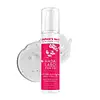What's inside
What's inside
 Key Ingredients
Key Ingredients

 Benefits
Benefits

 Concerns
Concerns

 Ingredients Side-by-side
Ingredients Side-by-side

Water
Skin ConditioningButylene Glycol
HumectantGlycerin
HumectantPEG-20 Sorbitan Isostearate
EmulsifyingPhenoxyethanol
PreservativePEG-60 Hydrogenated Castor Oil
EmulsifyingTriethylhexanoin
MaskingPropanediol
SolventPPG-10 Methyl Glucose Ether
Skin ConditioningSodium Hyaluronate
HumectantHydroxyethylcellulose
Emulsion StabilisingTocopherol
AntioxidantBHT
AntioxidantDisodium EDTA
Retinyl Palmitate
Skin ConditioningHydrolyzed Collagen
EmollientCaprylhydroxamic Acid
Helianthus Annuus Seed Oil
EmollientHydrolyzed Hyaluronic Acid
HumectantSodium Acetylated Hyaluronate
HumectantBenzoic Acid
MaskingSorbic Acid
PreservativeZea Mays Oil
EmulsifyingThioctic Acid
AntioxidantBeta-Carotene
Skin ConditioningSodium Hyaluronate Crosspolymer
HumectantPentylene Glycol
Skin ConditioningWater, Butylene Glycol, Glycerin, PEG-20 Sorbitan Isostearate, Phenoxyethanol, PEG-60 Hydrogenated Castor Oil, Triethylhexanoin, Propanediol, PPG-10 Methyl Glucose Ether, Sodium Hyaluronate, Hydroxyethylcellulose, Tocopherol, BHT, Disodium EDTA, Retinyl Palmitate, Hydrolyzed Collagen, Caprylhydroxamic Acid, Helianthus Annuus Seed Oil, Hydrolyzed Hyaluronic Acid, Sodium Acetylated Hyaluronate, Benzoic Acid, Sorbic Acid, Zea Mays Oil, Thioctic Acid, Beta-Carotene, Sodium Hyaluronate Crosspolymer, Pentylene Glycol
Aloe Barbadensis Leaf Juice
Skin ConditioningWater
Skin ConditioningHelianthus Annuus Seed Oil
EmollientSnail Secretion Filtrate
Skin ConditioningIsopropyl Palmitate
EmollientGlyceryl Stearate
EmollientCetyl Alcohol
EmollientStearic Acid
CleansingGlycerin
HumectantButyrospermum Parkii Butter
Skin ConditioningSimmondsia Chinensis Seed Oil
EmollientTocopheryl Acetate
AntioxidantPanthenol
Skin ConditioningRetinol
Skin ConditioningSymphytum Officinale Leaf Extract
Skin ConditioningCamellia Sinensis Leaf Extract
AntimicrobialXanthan Gum
EmulsifyingPentylene Glycol
Skin ConditioningPotassium Sorbate
PreservativeSodium Benzoate
MaskingPolysorbate 20
EmulsifyingAlcohol
AntimicrobialLecithin
EmollientPhenoxyethanol
PreservativeEthylhexylglycerin
Skin ConditioningAloe Barbadensis Leaf Juice, Water, Helianthus Annuus Seed Oil, Snail Secretion Filtrate, Isopropyl Palmitate, Glyceryl Stearate, Cetyl Alcohol, Stearic Acid, Glycerin, Butyrospermum Parkii Butter, Simmondsia Chinensis Seed Oil, Tocopheryl Acetate, Panthenol, Retinol, Symphytum Officinale Leaf Extract, Camellia Sinensis Leaf Extract, Xanthan Gum, Pentylene Glycol, Potassium Sorbate, Sodium Benzoate, Polysorbate 20, Alcohol, Lecithin, Phenoxyethanol, Ethylhexylglycerin
 Reviews
Reviews

Ingredients Explained
These ingredients are found in both products.
Ingredients higher up in an ingredient list are typically present in a larger amount.
Glycerin is already naturally found in your skin. It helps moisturize and protect your skin.
A study from 2016 found glycerin to be more effective as a humectant than AHAs and hyaluronic acid.
As a humectant, it helps the skin stay hydrated by pulling moisture to your skin. The low molecular weight of glycerin allows it to pull moisture into the deeper layers of your skin.
Hydrated skin improves your skin barrier; Your skin barrier helps protect against irritants and bacteria.
Glycerin has also been found to have antimicrobial and antiviral properties. Due to these properties, glycerin is often used in wound and burn treatments.
In cosmetics, glycerin is usually derived from plants such as soybean or palm. However, it can also be sourced from animals, such as tallow or animal fat.
This ingredient is organic, colorless, odorless, and non-toxic.
Glycerin is the name for this ingredient in American English. British English uses Glycerol/Glycerine.
Learn more about GlycerinHelianthus Annuus Seed Oil is the oil derived from the seeds of a Sunflower. Sunflower seed oil is non-fragrant. It is an emollient, meaning it helps to soften the skin.
Sunflower seed oil contains many fatty acids. The fatty acids found in sunflower seeds include (from highest amount to least): linoleic acid, myristic acid, palmitic acid, stearic acid, arachidic acid, oleic acid, and linolenic acid.
These fatty acids help the skin create ceramides. Ceramides play a role in repairing the skin barrier.
Helianthus Annuus Seed Oil helps moisturize the skin. This in turn helps the skin look more rejuvenated and smoother.
Sunflowers are rich in vitamin E.
Historians believe Indigenous cultures of North America domesticated sunflowers before corn. Thus they relied on sunflower oil for a variety of uses. One such use is moisturizing skin and hair.
Sunflower seed oil may not be fungal acne safe. We recommend speaking with a professional if you have any concerns.
Learn more about Helianthus Annuus Seed OilPentylene glycol is typically used within a product to thicken it. It also adds a smooth, soft, and moisturizing feel to the product. It is naturally found in plants such as sugar beets.
The hydrophilic trait of Pentylene Glycol makes it a humectant. As a humectant, Pentylene Glycol helps draw moisture from the air to your skin. This can help keep your skin hydrated.
This property also makes Pentylene Glycol a great texture enhancer. It can also help thicken or stabilize a product.
Pentylene Glycol also acts as a mild preservative and helps to keep a product microbe-free.
Some people may experience mild eye and skin irritation from Pentylene Glycol. We always recommend speaking with a professional about using this ingredient in your routine.
Pentylene Glycol has a low molecular weight and is part of the 1,2-glycol family.
Learn more about Pentylene GlycolPhenoxyethanol is a preservative that has germicide, antimicrobial, and aromatic properties. Studies show that phenoxyethanol can prevent microbial growth. By itself, it has a scent that is similar to that of a rose.
It's often used in formulations along with Caprylyl Glycol to preserve the shelf life of products.
Water. It's the most common cosmetic ingredient of all. You'll usually see it at the top of ingredient lists, meaning that it makes up the largest part of the product.
So why is it so popular? Water most often acts as a solvent - this means that it helps dissolve other ingredients into the formulation.
You'll also recognize water as that liquid we all need to stay alive. If you see this, drink a glass of water. Stay hydrated!
Learn more about Water